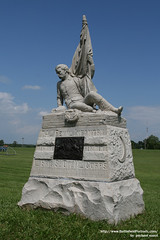"Maybe they should call them Killingfields instead of Battlefields..."
A quick thought experiment for today...
 |
| CC / by Michael Noirot |
Would calling these places, "Killingfield," shift the focus upon the carnage of war instead of the romance? Would calling these places Killingfields acknowledge the quite obvious fact that the land is still very much a cemetery? Would it help to quash some of the hokey reenactment impulse to flop around like a comical fish in mock death where men actually died in agonizing pain?
The National Park Service's sites at very least have a moratorium on this type of thing, the blackpowder regulations [PDF] dictating that, "opposing lines, the taking of casualties, hand-to-hand combat, or any other form of simulated warfare, are prohibited in all parks. Battle reenactments generate an atmosphere inconsistent with the memorial qualities of battlefields and other military sites placed in the Service’s trust." The lack of respect in that type of behavior is (thankfully) curtailed by the Park Service. Still, this does not change the fact that many reenactors dream of marching across battlefields and pretending to shoot at each other on the land where men died. "Wouldn't it be so hardcore?" is the question which pops from many folks' mouths in much the same tone of voice I use when I get ready to watch a new episode of Doctor Who: pure excitement. We call that tone a "squee" 'round here in the blag-o-nets.
"...the brigades are in position behind the rail fence, the guns are laid and ready in the woods and the furled flags are already loosened to break out and Pickett himself with his long oiled ringlets and his hat in one hand probably and his sword in the other looking up the hill waiting for Longstreet to give the word and it's all in the balance, it hasn't happened yet, it hasn't even begun yet...."
| Shelby's all queued up and ready to go. Just click play. |
Imagine a world where we renamed them "Antietam National Killingfield" and "Manassas National Killingfield." Where people hired a Licensed Guide to take them on a Killingfield Tour at Gettysburg. How might that small change in language affect how we think about those places? Interesting thought to ponder...
[EDIT: Scott Manning has a reply/his own reflections at Historian on the Warpath.]
Great topic! I started to post a comment and then it turned into a lengthy response on my website.
ReplyDeleteThis comment has been removed by a blog administrator.
ReplyDelete